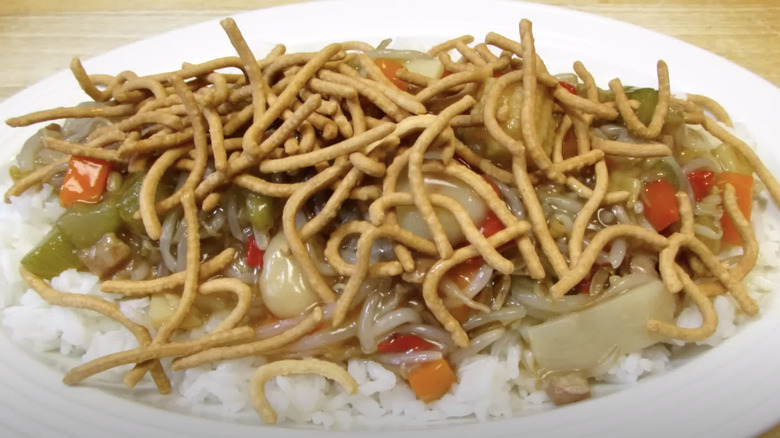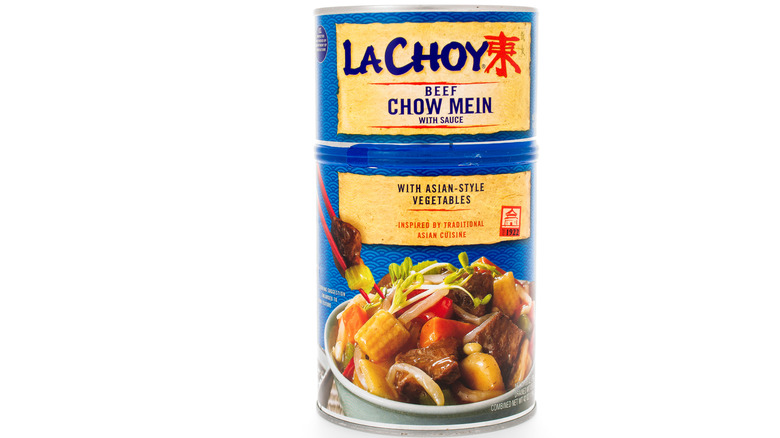Why You're Probably Better Off Not Buying Canned Chow Mein
Canned foods have an obvious appeal. They're time-saving, budget-friendly, and capable of lasting years on end in almost any environment. But the convenience isn't always worth it, and there are a number of canned foods you should avoid due to their questionable quality or nutritional value. Canned chow mein has to rank high on this list, being simultaneously unadvisable from a health perspective and, according to many opinions, flat-out gross.
For starters, canned chow mein bears almost no resemblance to the chow mein in Chinese restaurants, which combines fresh, springy noodles with stir-fried meat and vegetables. The canned concoction has none of this. It comes in two cans, one containing meat and sauce and the other containing mixed vegetables, including carrots, baby corn, and bean sprouts. Notice something missing? That's right; there are no noodles in canned chow mein. You buy them separately, and unlike the fresh, chewy noodles you get at a restaurant, these are fried to a crisp.
Canned chow mein was a popular dish for mid-century Americans, but public opinion has soured on it in recent years. Reviews for La Choy canned chow mein, the predominant brand on the market, are largely negative, commenting on a serious lack of flavor. Even those who grew up eating the stuff have soured on it since a recent alteration in the recipe, which turned the sauce from white to brown, has made ginger the only perceivable taste. But truthfully, canned chow mein was questionable from its very inception.
Canned chow mein has virtually no connection to real Chinese cuisine
Chow Mein has a heavy American influence to begin with. It developed from a traditional dish called ch'ao mien (Mandarin for "stir-fried noodles"), which Chinese immigrants in the United States adapted. It played a significant role in the expansion of Chinese-American food in the 1920s, a period some refer to as the chop suey era. Yet for decades after that, a number of Americans still had aversions to Chinese food based purely on unfamiliarity. This is where canned chow mein entered the picture.
Two companies pioneered canned chow mein, La Choy and Chun King, both of which were founded by non-Chinese businessmen. La Choy was founded in 1922 by Michigan native Wally Smith and Korean immigrant Ilhan New. This was a time when many Americans grouped all East Asians under the offensive umbrella term of "Oriental," and New was used to give the brand a sense of authenticity despite not being Chinese at all.
Chun King was founded in 1946 by Jeno Paulucci, the same man who invented Totino's Pizza Rolls. Paulucci's obituary in The New York Times includes a quote about Chun King's chow mein, of which he said, "I seasoned it to my own Italian taste." Make of that what you will. Both La Choy and Chun King were founded with the goal of making Americanized products to corner U.S. consumers too intimidated by the perceived exoticism of actual Chinese food.
Canned chow mein has a shockingly high sodium content
Chun King was bought out by La Choy in 1995, leaving the latter as the standard-bearer of canned chow mein. We already covered what reviewers think of the taste of La Choy chow mein, but it turns out that the nutritional content is an even more significant concern. A one-cup serving of La Choy canned chow mein contains 90 calories, but counting calories only scratches the surface of a food's nutritional value. It's important to look at the details; one element stands out when it comes to La Choy chow mein.
That one-cup serving contains a whopping 1,270 milligrams of sodium, equivalent to 55% of your recommended daily value. Meanwhile, those 90 calories only account for 4.5% of a 2,000-calorie-per-day diet. Canned chow mein provides a minuscule amount of fuel for your body while overloading it with sodium, leaving you in need of much more food throughout the day but with very little room for any more salt.
Plus, you need to remember that canned chow mein doesn't actually include noodles. Those are a separate product, and a half-cup serving of La Choy chow mein noodles contains more calories than the meat and veggie mixture, at 130. You can see how little you're getting out of those two cans. Meanwhile, the noodles add another 240 milligrams of sodium, so between the noodles and the chow mein mix, you exceed 65% of your recommended daily sodium intake.


